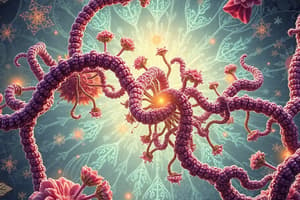Podcast
Questions and Answers
What is the term used to describe anything a drug interacts with to cause an effect?
What is the term used to describe anything a drug interacts with to cause an effect?
- Ligand
- Drug Receptor
- Binding Site
- Drug Target (correct)
Which of these scientists is credited with the development of the "side chain" chemical binding theory from immunology?
Which of these scientists is credited with the development of the "side chain" chemical binding theory from immunology?
- Clark
- Ehrlich (correct)
- Langley
- Gaddum
What is the term for the binding site that an endogenous agonist binds to?
What is the term for the binding site that an endogenous agonist binds to?
- Allosteric binding site
- Orthosteric binding site (correct)
- Active binding site
- Secondary binding site
What is the term for the ability of a ligand to generate an effect?
What is the term for the ability of a ligand to generate an effect?
Which of these is NOT a factor that contributes to the potency of a drug?
Which of these is NOT a factor that contributes to the potency of a drug?
What is the term for the binding site that other ligands bind to, besides the primary agonist?
What is the term for the binding site that other ligands bind to, besides the primary agonist?
Which of the following scientists established the theory of receptor action through their work with propranolol?
Which of the following scientists established the theory of receptor action through their work with propranolol?
What type of conformational change occurs in a receptor upon ligand binding?
What type of conformational change occurs in a receptor upon ligand binding?
What is the x-axis in a concentration-effect curve?
What is the x-axis in a concentration-effect curve?
What is the difference between a concentration-effect curve and a dose-response curve?
What is the difference between a concentration-effect curve and a dose-response curve?
What does the EC50 represent?
What does the EC50 represent?
What is the relationship between potency and EC50?
What is the relationship between potency and EC50?
How does a ligand with a higher affinity compare to a ligand with a lower affinity?
How does a ligand with a higher affinity compare to a ligand with a lower affinity?
What does efficacy refer to?
What does efficacy refer to?
What is the difference in efficacy and affinity between ligands A and C in the graph provided?
What is the difference in efficacy and affinity between ligands A and C in the graph provided?
What does it mean if two ligands have the same efficacy but different affinities?
What does it mean if two ligands have the same efficacy but different affinities?
Flashcards are hidden until you start studying
Study Notes
Receptor Theory
- Receptor theory is the main scientific theory of pharmacology, dating back to Ehrlich's "side chain" chemical binding theory from immunology.
Development of Receptor Theory
- Langley (1878, 1905) proposed a chemical binding theory for all drugs, which was later developed by others, such as Clark and Gaddum (1920s-1930s).
- The concept of receptors was firmly established by Sir James Black (1965) with the discovery of propranolol.
Definition of Receptors and Targets
- A "drug receptor" refers to anything a drug interacts with to cause an effect, but the term "drug target" is preferable.
- "Receptor" specifically refers to proteins that recognize and respond to endogenous signaling mediators.
Binding Sites
- Receptors have an active ("orthosteric") binding site for endogenous, activating ligands (agonists) with high specificity.
- Ligand binding induces conformational changes to activate the receptor.
- Receptors may also contain secondary ("allosteric") binding sites for other ligands.
Affinity and Efficacy
- Affinity refers to the ability of a ligand to bind to a target.
- Efficacy refers to the ability of a ligand to generate an effect.
- Together, affinity and efficacy determine potency, or the ability of a ligand to generate a response.
Concentration-Effect and Dose-Response Curves
- Concentration-effect curves measure the effect of a drug at the target site.
- Dose-response curves measure the physiological response to a systemically administered drug.
- The x-axis is typically plotted on a logarithmic scale.
Affinity and Efficacy on D-R Curves
- Ligands with different affinities or efficacies will have distinct D-R curves.
- Ligands with the same efficacy but different affinities will have different EC50 values.
- Ligands with the same affinity but different efficacies will have different Emax values.
EC50 and Potency
- EC50 is the concentration at which the effect is half maximal.
- Potency is the concentration of drug required to cause an effect, measured by EC50.
Studying That Suits You
Use AI to generate personalized quizzes and flashcards to suit your learning preferences.




